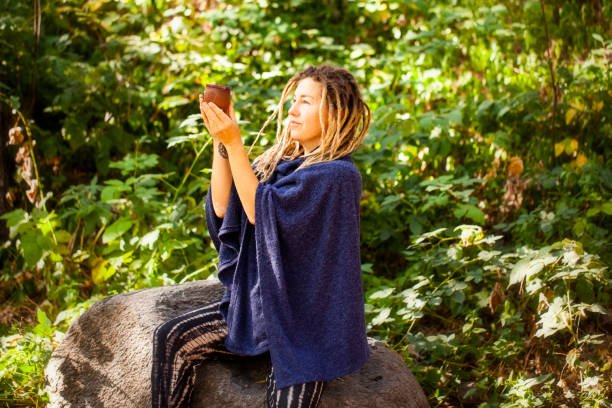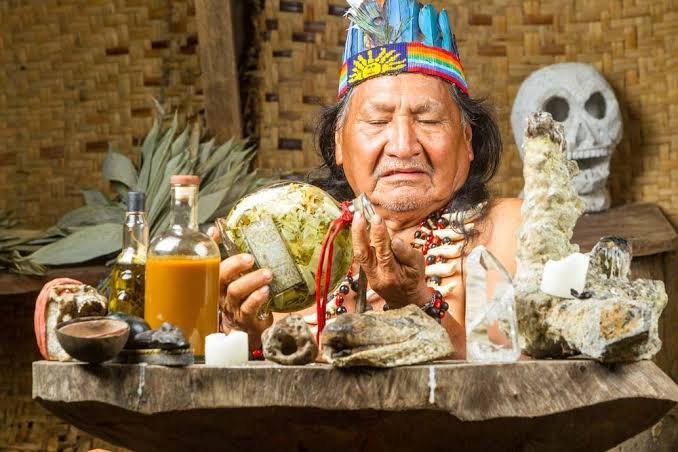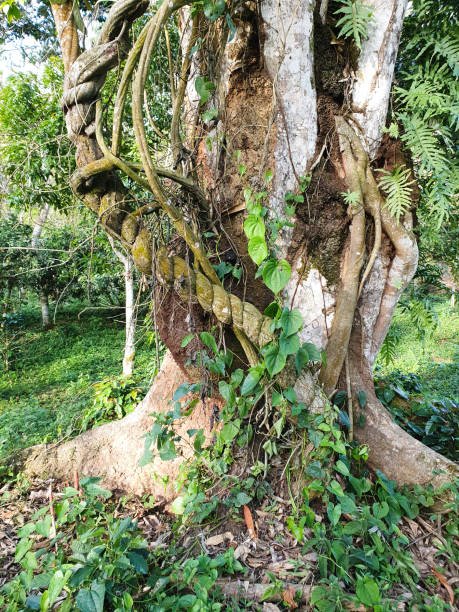WHAT IS AYAHUASCA?

In truth, Ayahuasca is the television of the forest.
It is not out of place to find people seeking wellbeing through methods that do not directly reflect the practice of modern medicine. Most of these methods do not cater to physical wellbeing alone as modern medical practice does. They rather seek to also involve a person’s emotion, mind, and spirit in achieving total wellbeing. One of such methods as practiced mostly in Latin America is the Ayahuasca.
The fundamental beliefs that inspire its practice don’t pitch its tent far from holistic health since holistic health approaches wellness from the standpoint of the whole person; physical, mental and spiritual.¹
Although it has been practiced for centuries now, what Ayahuasca fully represents remains vague to many people. Even for those who know a thing or two about it, they are uncertain if its healing and therapeutic powers are factual or only myth. Find out the truth, the benefits, and the side effects of Ayahuasca in this article.
WHAT IS AYAHUASCA?
It derives its name from pan-Amazonian origin. It is named after a brew prepared for social and spiritual ceremonies which have a psychoactive effect on people when it is consumed. It is peculiar to indigenous dwellers of the Amazon regions of South America.² It has the ability to induce hallucinations, alter perception, tamper with consciousness and change behavioral patterns. It is usually a brewed mixture of the Psychotria viridis plant and the vine of Banisteriopsis caapi. Sometimes, other ingredients are added to the brewed mixture.³
Ayahuasca came into global perspective in the 1500s when Christian missionaries from Europe came down to the Amazon basin, naming it “the work of the devil”. However, historical proof validates that Ayahuasca had been in use as far back as 1,000 years ago. This was after an interesting discovery was made in a cave located somewhere in Bolivia’s southwest in the year 2010. The discovery revealed a bundle of items believed to be shamanic ingredients which also contained materials used in the preparation of Ayahuasca⁴
Despite its age-long use, ayahuasca is still used today for healing, social and spiritual activities. Its use also now transcends into modern religious practices with some religious groups incorporating ayahuasca use with the Santo Diame group being the most popular of these groups.⁵

WHAT ARE THE CLAIMS ABOUT AYAHUASCA?
Although many experts do not validate the use of ayahuasca for mental healing, many people have held on to its use for some reason. It is widely believed to cure mental trauma and open one’s mind to perceive things they wouldn’t ordinarily perceive. It is believed to cure stress and depression due to its antidepressant content and some users believe that it can make one interact with spiritual beings which they wouldn’t have seen at normal mental levels.
WHAT IS THE SCIENCE BEHIND THE AYAHUASCA EXPERIENCE?
Thanks to science we have an explanation to why people experience hallucinations, excitement, semi-consciousness, and the likes after the consumption of Ayahuasca. The major content of ayahuasca brew is Banisteriopsis caapi and Psychotria viridis which both have chemicals that induce hallucination.
Psychotria viridis has a naturally occurring chemical called N,N-dimethyltryptamine (DMT), a mind-altering substance. DMT is such a potent hallucinogenic substance however its level of bioavailability is low. This is because the enzyme known as monoamine oxidases otherwise known as MAOs present in the liver and gastrointestinal tract act on the DMT so quickly that get broken down before its effect is felt.⁶
If the DMT content must have an effect on its user, then it must be combined with a substance that inhibits the actions of MAOs. That’s where Banisteriopsis caapi comes in! Although it is also a hallucinogen, it contains β-carbolines which have MAO inhibiting potentials.⁷
The inhibitors stop the action of the MAO enzyme which makes it possible for DMT to remain untouched till it is assimilated into the blood via the small intestine and then to the brain.
The brew made out of the combination of both plants can have a great effect on the central nervous system, causing varying experiences such as euphoria, trances, hallucinations, out of body experiences, etc.⁸ When DMT gets to the brain, it induces a psychedelic effect due to its influence on the visual cortex of the brain.⁹
WHAT ARE THE TESTIMONIES ABOUT AYAHUASCA USE?
Usually, the effect of Ayahuasca begins to take its toll within 20 – 60 minutes after ingestion and can remain for 2-6 hours. For many people, the feelings are usually heightened emotional activity, unusual visual experience, and gastrointestinal problems. As gathered from several testimonies, the effect of ayahuasca can be summed up into the following
- Powerful visual and auditory visions
- Heightened excitement
- Mind-altering hallucinations which sometimes change mental perceptions even after it has worn out.
- Fear and anxiety
- Diarrhea and vomiting which some practitioners say it’s normal and healthy as a cleansing mechanism.¹⁰
WHAT ARE THE REPORTED BENEFITS OF AYAHUASCA?
Many people who took Ayahuasca reported that it had long-term, positive life-altering effects on them. Perhaps, their testimonies may come as a result of the substance’s effect on the nervous system. Some of the benefits as reported by scientific research include:
- It may serve as a protection for the brain due to the neuroprotective qualities of DMT and β-carbolines. They have also been found to restore degenerating neurocells.¹¹
- It may improve the capacity of one’s mindfulness which has a positive impact on psychological health.12
- It may be useful in the treatment of anxiety, addiction, post-traumatic stress disorders (PTSD), and treatment-resistant depression.13

ARE THERE POTENTIAL SIDE EFFECTS TO AYAHUASCA USE?
Taking ayahuasca is said to be beneficial but the ingestion of this hallucinogenic brew isn’t without some notable side effects. These side effects may be distressing and in some cases, fatal. A number of common side effects of ayahuasca consumption include:
- Vomiting
- Panic
- Feeling miserable
- Diarrhea
- Paranoia
Ayahuasca doesn’t combine well with certain medications such as cough medicines, Parkinson’s disease medication, and anti-depressants, among others. Interaction between these medications and ayahuasca may cause fatal consequences.6 Taking ayahuasca has also been linked with increased pulse rate and blood pressure which may badly affect heart health.14
FINAL THOUGHT
Positive testimonies abound concerning the use of ayahuasca for psychological and mental benefits with medical research verifying some of them. However, there are also side effects to its use too which also have been scientifically proven. It is important to note that although ayahuasca can pass as a form of holistic medicine, it is not entirely safe for everyone. Having done several researches in holistic medicine and obtained facts, I wish to share with you holistic health habits that can give you the bodily vitality and psychological wellness you crave for. You can gift yourself holistic wellness via the content I shared in this book Lead A Horse To Water. A firm belief that one can be healthy in mind, body, and spirit is a belief we know is true and can be gotten by you. That’s what we represent at Holistic Live Younger.

“POSITIVE TESTIMONIES ABOUND CONCERNING THE USE OF AYAHUASCA FOR PSYCHOLOGICAL AND MENTAL BENEFITS WITH MEDICAL RESEARCH VERIFYING SOME OF THEM. HOWEVER, THERE ARE ALSO SIDE EFFECTS TO ITS USE TOO WHICH ALSO HAVE BEEN SCIENTIFICALLY PROVEN”
- Sakr, N. (2021). “Lead A Horse To Water”. pp. 8
- MacRae Edward (1999). “The Ritual and Religious Use of Ayahuasca in Contemporary Brazil”. (PDF) Geneva, Switzerland.
- Erin Blakemore (2019). “Ancient hallucinogens found in 1,000-year-old shamanic pouch”. Nationalgeographic.com.
- Labate B.C., Rose I.S., and Santos R.G. (2009). “Ayahuasca Religions: a comprehensive bibliography and critical essays”. Santa Cruz: Multidisciplinary Association for Psychedelic Studies – MAPS. ISBN 978-0-9798622-1-2.
- Benjamin J. Malcolm and Kelly C. Lee (2018). “Ayahuasca: An ancient sacrament for treatment of contemporary psychiatric illness?” Ment Health Clin. PMCID: PMC6007657 PMID: 29955496
- Steven A. Barker (2018). “N, N-Dimethyltryptamine (DMT), an Endogenous Hallucinogen: Past, Present, and Future Research to Determine Its Role and Function”. Front Neurosci. PMID: 30127713 PMCID: PMC6088236 doi:10.3389/fnins.2018.00536.
- RIBA, J. Human Pharmacology of Ayahuasca. Doctoral Thesis: Universitat Autònoma de Barcelona, 2003.
- De Araujo, DB; Riberio, S; Cecchi, GA; Carvalho, FM; Sanchez, TA; Pinto, JP; de Martinis, BS; Crippa, JA; Hallack, JE; Santos, AC (2012). “Seeing with the eyes shut: neural basis of enhanced imagery following Ayahuasca ingestion”. Human Brain Mapping. 33 (11): 2550 – 60. doi:10.1002/hbm.21381. PMC 6870240. PMID 21922603 S2CID18366684.
- Silvia Graziano, Laura Orsolini, Maria Concetta Rotolo, Roberta Tittarelli, Fabrizio Schifano, and Simona Pichini (2017). “Herbal Highs: Review on Psychoactive Effects and Neuropharmacology”. Curr Neuropharmacol.2017 Jul; 15(5): 750 -761. doi:10.2174/1570159X14666161031144427 PMCID: PMC5771051 PMID: 27799032
- Attila Szabo, Attila Kovacs, Jordi Riba, Srdjan Djurovic, Eva Rajnaolgyi, and Ede Frecska (2016). “The Endogenius Hallucinogen and Trace Amine N,N-Dimethyltryptamine (DMT) Displays Potent Protective Effects against Hypoxia via Sigma-1 Receptor Activation in Human Primary Ipsc-Derived Cortical Neurons and Microglia-Like Immune Cells”. Front Neurosci. 216; 10:423. doi: 10.3389/fnins.2016.00423 PMCID: PMC5021697 PMID: 27683542
- Joaquim Soler, Matilde Elices, Elisabeth Dominguez-Clave, Juan C. Pascual, Amanda Feilding, Mayte Navarro-Gil, Javier Garcia-Campayo, and Jordi Riba (2018). “Four Weekly Ayahuasca Sessions Lead to Increases in ‘Acceptance’ Capacities: A Comparison Study With a Standard 8-Week Mindfulness Training Program”. Front Pharmacol. 2018; 9: 224. doi: 10.3389/fphar.2018.00224 PMCID: PMC5869920 PMID: 29615905
- Rafael G. dos Santos, Flávia L. Osório, José Alexandre S. Crippa, Jordi Riba, Antônio W. Zuardi, and Jaime E. C. Hallak (2016). “Antidepressive, anxiolytic, and antiaddictive effects of ayahuasca, psilocybin and lysergic acid diethylamide (LSD): a systematic review of clinical trials published in the last 25 years”. Ther Adv Psychopharmacol. 2016 Jun; 6(3): 193 – 213. doi: 10.1177/2045125316638008 PMCID: PMC4910400 PMID: 27354908
- Jordi Riba, Marta Valle, Gloria Urbano, Mercedes Yritia, Adelaida Morte, and Manel J Barbanoj (2003). “Human pharmacology of ayahuasca: subjective and cardiovascular effects, monoamine metabolite excretion, and pharmacokinetics”. J Pharmacol Exp Ther. 2003 Jul; 306(1):73-83. doi: 10.1124/jpet.103.049882. PMID: 12660312


